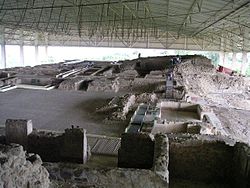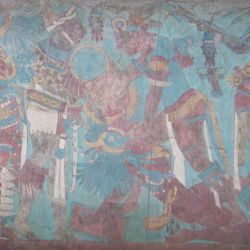| Revision as of 22:40, 28 February 2009 editArthurBot (talk | contribs)259,345 editsm robot Adding: ru:Какаштла← Previous edit | Revision as of 19:26, 28 March 2009 edit undoWikHead (talk | contribs)Pending changes reviewers, Rollbackers106,029 editsm Fixed typo, "is is"Next edit → | ||
| Line 23: | Line 23: | ||
| ==Visiting the site== | ==Visiting the site== | ||
| ] | ] | ||
| The archaeological site is maintained by the government's ] (INAH) and |
The archaeological site is maintained by the government's ] (INAH) and is open Tuesday to Sunday, from 8:00 to 17:30. The admission is $46 MXP.<ref>Further information: www.dti.inah.gob.mx</ref> In addition to the ruins, there is a small but well presented museum containing models of how the city appeared in its heyday and a collection of artifacts found on the site. | ||
| Due to heavy hail storms on May 21, 2007, the archaeological site was closed until April 2008.<ref>Details: | Due to heavy hail storms on May 21, 2007, the archaeological site was closed until April 2008.<ref>Details: | ||
Revision as of 19:26, 28 March 2009


Cacaxtla is an archaeological site located near the southern border of the Mexican state of Tlaxcala.
History
Cacaxtla was the capital of region inhabited by the Olmeca-Xicalanca people. It is not known with certainly the origins of the Olmeca-Xicalanca, but they are assumed to come from the Gulf coast region, and were perhaps Maya settlers who arrived in this part of central Mexico around 400 CE.
The term "Olmeca-Xicalanca" was first mentioned by Tlaxcalan historian Diego Muñoz Camargo at the end of the 16th century. This historian described Cacaxtla as the principal settlement of the “Olmeca”, although what we today refer to as the Olmec culture ended ~400 BCE, that is, almost 800 years earlier.
After the fall of the nearby city Cholula (ca. 650 - 750) -- in which the Cacaxtlecas might have been involved -- Cacaxtla became the hegemonic power in this part of the Tlaxcala–Puebla valley. Its ascendancy came to an end around 900 CE and, by 1000, the city had been abandoned.
Modern history of the site
The site was rediscovered in 1975 by looters, but quickly came to the attention of archaeologists that same year.
The city
The centre of the city of Cacaxtla was the 200-metre-long, 25-metre-high Gran Basamento – a natural platform offering a fine defensive position and commanding views over the surrounding terrain. The city's main religious and civil buildings were located on this platform, as were the residences of the priest class. Several other smaller pyramids and temple bases stand in the vicinity of the main platform.

Because Cacaxtla's main basamento was not excavated until the 1980s, many of the original coloured wall decorations have been preserved and can be appreciated in situ by visitors to the site. Of particular interest is the fact that most of the murals seem to combine the symbology of Altiplano cultures with influences from the Maya, making Cacaxtla unique in this regard.
The most famous of Cacaxtla's preserved paintings is the "Battle Mural", or Mural de la batalla, located in the northern plaza of the basamento. Dating from prior to 700, it is placed on the sloping limestone wall of a temple base and is split in two by a central staircase. It depicts two groups of warriors locked in battle: on the one side are jaguar warriors, armed with spears, obsidian knives, and round shields, who are locked in battle with an army of bird warriors (some of whom are shown naked and in various stages of dismemberment).
Visiting the site

The archaeological site is maintained by the government's National Institute of Anthropology and History (INAH) and is open Tuesday to Sunday, from 8:00 to 17:30. The admission is $46 MXP. In addition to the ruins, there is a small but well presented museum containing models of how the city appeared in its heyday and a collection of artifacts found on the site.
Due to heavy hail storms on May 21, 2007, the archaeological site was closed until April 2008. The site was to re-open on April 30, 2008.
See also
- Xochitecatl, a neighbouring archaeological site, approximately 1 km to the west.
Notes
- Further information: www.dti.inah.gob.mx
- Details: http://www.inah.gob.mx/Banners/cacaxtla_comunicado/index.html
References
- Nichols, Deborah L. (2001). "Central Mexico Postclassic". In Peter N. Peregrine and Melvin Ember (eds.) (ed.). Encyclopedia of Prehistory, Vol. 5: Middle America. New York : Kluwer Academic/Plenum Publishers, in conjunction with the Human Relations Area Files at Yale University. pp. 22–53. ISBN 0-306-46259-1. OCLC 84088734.
{{cite book}}:|editor=has generic name (help); Unknown parameter|coauthors=ignored (|author=suggested) (help); templatestyles stripmarker in|author=at position 1 (help); templatestyles stripmarker in|coauthors=at position 5 (help)CS1 maint: numeric names: authors list (link)
External links
- Cacaxtla at INAH Template:Es icon
- Proyecto La pintura mural prehispánica en México, UNAM
- Tour by Mexico
- INAOEP
19°14′35″N 98°20′24″W / 19.24313°N 98.34000°W / 19.24313; -98.34000
Categories: